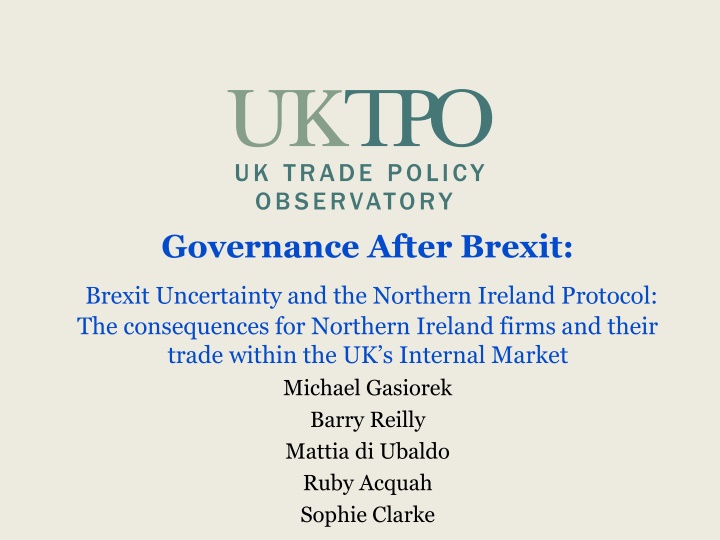
Impact of Brexit on Northern Ireland Firms' Trade and Regulatory Barriers
Explore the consequences of Brexit uncertainty and the Northern Ireland Protocol on trade within the UK's Internal Market for Northern Ireland firms. Learn about regulatory barriers, changes in trade patterns, and key results affecting various sectors post-Brexit.
Download Presentation

Please find below an Image/Link to download the presentation.
The content on the website is provided AS IS for your information and personal use only. It may not be sold, licensed, or shared on other websites without obtaining consent from the author. If you encounter any issues during the download, it is possible that the publisher has removed the file from their server.
You are allowed to download the files provided on this website for personal or commercial use, subject to the condition that they are used lawfully. All files are the property of their respective owners.
The content on the website is provided AS IS for your information and personal use only. It may not be sold, licensed, or shared on other websites without obtaining consent from the author.
E N D
Presentation Transcript
Governance After Brexit: Brexit Uncertainty and the Northern Ireland Protocol: The consequences for Northern Ireland firms and their trade within the UK s Internal Market Michael Gasiorek Barry Reilly Mattia di Ubaldo Ruby Acquah Sophie Clarke
Overview Following the referendum, and subsequently and even since the Windsor Framework there has been uncertainty for firms in Northern Ireland, and since the TCA the introduction of some barriers to trade between GB and NI. Key aim is to explore the impact on firms in NI: sales and purchases from different destinations, including trade with GB. Specifically interested in the role of regulatory barriers to trade. Based on constructing indices of regulatory intensity at the product level; and use firm level data. Two applications: Impacts on NI firms prior to exit from the EU, and ex post since exit. Do changes in regulatory intensity impact differentially on intra-EU imports v extra-EU imports. 2
The importance of regulatory barriers A key principle of the Single Market is the mutual recognition of goods and services. Once a product is lawfully placed on the market in one Member State, it can be marketed in another Member State without barriers. This therefore applies to NI but not GB. What matters is not only whether the UK and EU recognise each other standards, but the arrangements for proving conformity to those standards. In the UK-EU TCA here is no chapter on mutual recognition of conformity assessment Goods made in GB for sale in the EU must not only conform to EU standards, but they must also provide EU-overseen paperwork to prove this conformity. 3
NI effects: key results In aggregate: post-referendum and post-withdrawal agreement NIpurchases shift away from UK/Ireland: Purchases from other EU and Rest of World (RoW) increase relative to purchases from NI, GB, or Ireland. At the sectoral level: Results more nuanced, e.g., import of transport equipment, furniture, fabricated metal from ROW increasing, while purchases of computer & electronics, electrical equip., and transport equip. from GB falling For retail and wholesale: Post withdrawal: purchases from GB declined while they increased from Ireland, other EU and ROW Post Brexit and Post withdrawal sales to all destinations except to NI domestically increased. 5
No. of regulations for different product groups 40 35 30 25 20 15 10 5 0 1 3 5 7 9 11 13 15 17 19 21 23 25 27 29 31 33 35 37 39 41 43 45 47 49 51 53 55 57 59 61 63 65 67 69 71 73 75 78 80 82 84 86 88 FBT Min Chem R,P,L W&P Tex&Cl Cer&Metals Mach Transp Other 6
Does regulatory intensity matter? Exports to Ireland and the Rest of the EU tend to be in more regulatory intensive sectors. But: There is no evidence that changes in trade (either positive or negative) are associated with regulatory intensity Similarly scant evidence that regulatory intensity has impacted on NI purchases from GB A key issue in the Windsor Framework relates to the use of intermediates by NI firms which by and large now have to go through the red lane We find that exports to the EU go down the more firms purchase intermediate inputs from GB in more regulatory intensive sectors 7
Regulatory Intensity and EU imports We test how EU imports from both EU and non-EU countries are affected by changes in EU regulations over 2012-2018 We exploit a gravity setting with a very stringent fixed effects specification We examine the role of: the number of regulations applying to each product, and three different indices which capture the importance of standards, the need for conformity assessment, and compliance measures Main findings: o looking at the no. of regulations, imports from both EU and non-EU countries are negatively affected. o we find negative effects also on both EU and non-EU countries for compliance measures. o Standards and conformity: o No impact on intra-EU trade. o Positive impact on imports from non-EU countries. The positive effects are driven by high-income non-EU countries. Suggests that once third country firms conform to standards this increases their access to the EU market. 8
Thank you https://blogs.sussex.ac.uk/uktpo Follow @uk_tpo 9






















